Kerala Plus One Botany Chapter Wise Questions and Answers Chapter 5 Cell The Unit of Life
Plus One Botany Cell The Unit of Life One Mark Questions and Answers
Question 1.
Which organelle is not a part of the endomembrane system?
(a) lysosome
(b) vacuole
(c) mitochondria
(d) Golgi complex
Answer:
(c) mitochondria
Question 2.
Smooth endoplasmic reticulum is well developed in cells which synthesise
(a) steroids
(b) proteins
(c) carbohydrates
(d) all of these
Answer:
(a) steroids
Question 3.
The type of ribosome found in prokaryotes is
(a) 70 S
(b) 80 S
(c) 60 S
(d) 50 S
Answer:
(a) 70 S
Question 4.
Who proposed the fluid mosaic model of plasma membrane in 1972?
(a) Singer and Nicolson
(b) Rober Hooke
(c) Rrobertsons model
(d) Camilo golgi
Answer:
(a) Singer and Nicolson
Question 5.
An organelle with internal cross section showing the characteristic 9 + 2 arrays is
(a) microtubule
(b) microfilament
(c) cilia and flagellum
(d) tubulin
Answer:
(c) cilia and flagellum
Question 6.
Smaller, lipid-soluble molecules diffuse faster through cell membrane, but the movement of hydrophilic substances are facilitated by certain biomolecules named as ____________
Answer:
Proteins.
Question 7.
Name the cell organelle rich in acid hydrolase.
Answer:
Lysosome
Question 8.
Name the stacked particle present on the inner sur¬face of inner mitochondrial membrane.
Answer:
Oxysomes
Question 9.
Give the chemical nature of ribosomes.
Answer:
rRNAs and proteins
Question 10.
Observe the relationship between the first two terms and fill up the blanks.
- Mitochondria: Cristae
Chloroplast: ………. - Moss: Capsule
Fern: ………….
Answer:
- Grana
- Sporangium
Question 11.
Mark the odd one out.
- Nucleus; Nucleoli; Centriole; Chromosome
- Family, class, taxon, phylum
Answer:
- Centriole
- Taxon
Question 12.
Name the protein associated with chromosomes.
Answer:
Histones
Question 13.
The cell wall of Bacterium is made up of
(a) Cellulose
(b) Hemi cellulose
(c) Lignin
(d) Peptidoglycan
Answer:
(d) Peptidoglycan.
Question 14.
ETS is associated with F0-F1 particles and many respiratory enzymes. What is the role of F0-F1 particles in mitochondria?
Answer:
ATP synthesis
Question 15.
Why is nucleus called the director of the cell?
Answer:
It controls and coordinates all the cellular functions.
Question 16.
What will you call a cell not having ER, Golgi body, mitochondria, nuclear membrane, etc.
Answer:
Prokaryotic cell
Question 17.
Which organelles are called ribonucleoprotein particles of the cell?
Answer:
Ribosome
Question 18.
Name which cell organelle is associated with secretory activity.
Answer:
Golgi body
Question 19.
Identify the powerhouse of a cell. Give justification.
Answer:
Mitochondria – synthesis of ATP
Question 20.
Which of the following is not true of a eukaryotic cell?
(a) It has 80S type of ribosome present in the mitochondria
(b) It has 80S type of ribosome present in the cytoplasm
(c) Mitochondria contain circular DNA
(d) Membrane-bound organelles are present
Answer:
(a) lt has 80S type of ribosome present in the mitochondria.
Question 21.
Which of the following statements is true for a secretory cell?
(a) Golgi apparatus is absent
(b) Rough Endoplasmic Reticulum (RER) is easily observed in the cell
(c) Only Smooth Endoplasmic Reticulum (SER) is present
(d) Secretory granules are formed in nucleus.
Answer:
(b) Rough Endoplasmic Reticulum (RER) is easily observed in the cell
Question 22.
Name the compound which gives fluidity and functional specificity to biomembranes.
Answer:
Fluidy by lipids and functional specificity by proteins
Question 23.
Which of the following is correct?
- Cells of all living organisms have a definite nucleus
- Both animal and plant cells have a well-defined cell wall.
Answer:
- false
- false
Plus One Botany Cell The Unit of Life Two Mark Questions and Answers
Question 1.
While studying the stages of meiosis following features observed at one stage.
- Pairing of homologous chromosomes.
- Formation of synaptonemal complex. Identify the stage.
Answer:
- Zygotene
- Pachytene
Question 2.
Make a list of organelles that function as the cytoskeleton.
Answer:
The endoplasmic reticulum, microtubules, microfilaments, and intermediate fibers.
Question 3.
Name two cell organelles that are double membrane-bound. Write the main functions of each.
Answer:
- Chloroplast- Photosynthesis
- Mitochondria – cellular respiration
Question 4.
Name the cell organelles in the cell which act as the following.
- Protein factories
- Powerhouse
- Disposal unit
- Control centres
Answer:
- Ribosome
- Mitochondria
- Lysosomes
- Nucleus
Question 5.
Analyse the table and arrange the matter in an appropriate order.
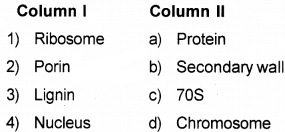
Answer:
1) Ribosome – 70S
2) Porin – Protein
3) Lignin – Secondary wall
4) Nucleus – Chromosome
Question 6.
Bacterial cell envelope is a complex structure. It is made up of various layers. Name the different layers in the Bacterial cell envelope.
Answer:
Glycocalyx, cell wall, and plasma membrane.
Question 7.
Pick up the odd one and state reason for your answer.
Golgi bodies, Nucteolus, Nucleus, Lysosome.
Answer:
Nucleolus. Remaining three are major cell organells seen in cytoplasm.
Question 8.
Mitochondria is called powerhouse of the cell. Comment.
Answer:
Mitochondria are the centres of production, storage, and distribution of energy for various metabolic activities of cell.
Question 9.
Table which shows a comparison of cell organisation in prokaryotes and eukaryotes. Complete the table.
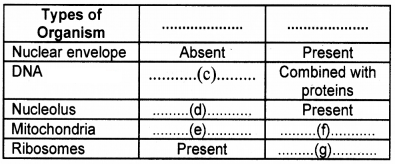
Answer:
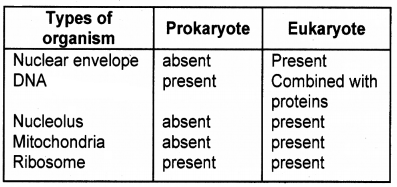
Question 10.
Observe the diagrams of two different phases of mitosis given below and write their names..
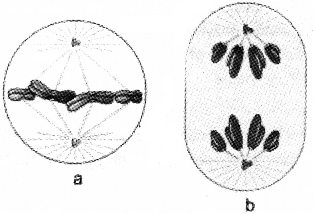
Answer:
- A- Metaphase
- B – Anaphase
Question 11.
Interphase in cell cycle is referred to as resting phase. Do you consider this statement true? Substantiate your answer.
Answer:
No. Synthesis of DNA, RNA & Protein occurs hence it is active stage.
Question 12.
Some statements related to certain cell organelles are given in column A. Identify the organelles and give their names correctly against each statement in column B.

Answer:

Question 13.
How RER is different from SER?
Answer:
- RER – Rough endoplasmic reticulum
Contains ribosomes – protein synthesis - SER – Smooth endoplasmic reticulum
Devoid of ribosome – lipid synthesis & storage
Question 14.
Most accepted model of Biomembrance is best referred as ‘Protein Icebergs in the sea of Lipid”.
- Name the most accepted structural model for the Biomembrane.
- Who proposed it?
Answer:
- Fluid mosaic model
- Singer & Nicholson
Question 15.
Functions and names of organells are given below arrange them into a table.
Mitochondria, Endoplasic reticulum, Ribosome, Chloroplast, protein synthesis, storage of energy, cytoskeleton, photosynthesis.
Answer:
- Mitochondria – Storage of energy
- Endoplasmic reticulum – Cytoskeleton
- Ribosome – Protein synthesis
- Chloroplast – Photosynthesis
Question 16.
Identify the given diagram. Copy and label the parts.
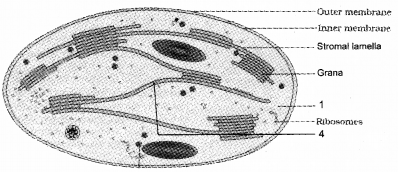
Answer:
- 1 – Stroma
- 4 – Fret channels
Question 17.
Match the following.
| A | B |
| Cristae | Chloroplast |
| Zygotene | Golgi apparatus |
| Mesosome | Synapsis |
| Thylakoid | Mitochondria |
| Cisternae | Plasma membrane |
Answer:
| Cristae | Mitochondria |
| Zygotene | Synapsis |
| Mesosome | Plasma membrane |
| Thylakoid | Chloroplast |
| Cisternae | Golgi apparatus |
Question 18.
Different types of chromosomes based on the position of centromere are given below.
- Classify them with necessary explanation.
- What is the peculiarity of the chromosome “C”?
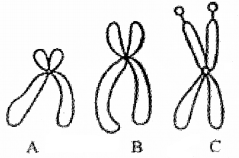
Answer:
1.
- A – Acrocentric chromosome – The centromere is near the end of the chromosome.
- B – Sub-metacentric chromosome – the centromere is near the middle of the chromosome.
- C – Metacentric chromosome – The centromere is at the middle of the chromosome,
2. It has both secondary constriction and a satellite.
Question 19.
Name the organelles which act as the following.
- cell’s circulatory system
- protein factories
- powerhouse
- disposal units
- control centres
Answer:
- Endoplasmic reticulum
- Ribosomes
- Mitochondria
- Lysosomes
- Nucleus
Question 20.
Different types of chromosomes based on the position of centromere are given below. Classify them with necessary explanation. What is the peculiarity of the chromosome “D”?

Answer:
- A- metacen trie – media nee centromere/Satel I ite chromosome.
- B – sub metacentric – centromere just away from median position
- C – acrocentric
- D – Telocentric – Centromere close to the end or terminal
Question 21.
Membrane-bound distinct structures are called organelle. An organelle that is not bounded by membrane is seen in the chloroplast and mitochondria.
- Identify cell organelle.
- Write down its functions.
Answer:
- Ribosome
- Protein synthesis
Question 22.
Different cells have different sizes. Arrange the following cells in ascending order of their size. Choose the correct option among the following.
i. Mycoplasma
ii. Ostrich eggs
iii. Human RBC
iv. Bacteria
Answer:
i – iv – iii – ii
Question 23.
Is extra genomic DNA present in prokaryotes and eukaryotes? If yes, indicate their location in both the types of organisms.
Answer:
It is present in cytoplasm of prokaryotes called plasmids
Question 24.
The genomic content of the nucleus is constant for a given species whereas the extrachromosomal DNA is found to be variable among the members of a population. Explain.
Answer:
- Transfer of hereditary characters from one generation to next takes place with the help of nucleus. But
- extrachromosomal DNA is not under the control of nuclear DNA its copy number varies in different organism.
Question 25.
Briefly give the contributions of the following scientists in formulating the cell theory.
- Robert Virchow
- Schielden and Schwann
Answer:
- Omnis cellula-e-cellular means new cells arise from pre-existing cells. It is the contribution of Rudolf Virchow.
- They have independently formulated the concept of cell theory i.e all cells are composed of cells and their products.
Schielden and Schwann-botanist and zoologist respectively.
Question 26.
Since the functions of certain membranous organelles are coordinated they are considered together as endomembrane system. Name the organelles included in this group.
Answer:
Endoplasmic reticulum, Golgi apparatus, Lysosome, and vacuole.
Question 27.
An organelle is called “The powerhouse of the cell”
- Name the organelle.
- Why is it said so?
Answer:
- Mitochondria
- Here the Energy (ATP) production, storage, and distribution takes place. So it is called a powerhouse of the cell.
Question 28.
The fluid mosaic model is a widely accepted model of cell membrance. Why?. Who proposed this model?
Answer:
It is the model of the plasma membrane consists of proteins and phospholipid bilayer. It is otherwise known as protein and iceberg in a sea of lipids. Singer and Nicolson
Question 29.
Match the column A, B & C Appropriately
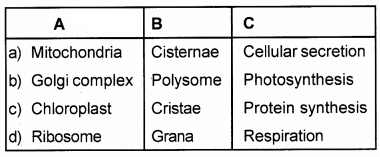
Answer:

Question 30.
A non-membrane cell organelles is common to both prokaryotes and eukaryotes.
- Which is that cell organelle?
- What is its function?
Answer:
- Ribosome
- It helps in protein synthesis. Ribosome is the protein synthesising machinery in both prokaryotes & Eukaryotes.
Question 31.
While looking through the microscope Ramesh saw few organisms. Help him to distinguish these organisms into Prokaryotes and Eukaryotes.
Answer:
- Prokaryotic organisms are single celled but without definite nucleus.
- Eukaryotic organisms are many celled with definite nucleus.
Question 32.
Cancer cells have numerous ribosomes’ Comment.
Answer:
Cancer cells undergoes uncontrolled and unwanted multiplication. It requires protein in large amounts. Hence numerous ribosomes are found in cancer cells.
Question 33.
| A | B |
| a. Ribosomes | photosynthesis |
| b. Golgi Apparatus | hydrolytic enzymes |
| c. Lysosomes | protein synthesis |
| d. Plastids | glycolipids |
Answer:
| A | B |
| Ribosomes | protein synthesis |
| Gogi apparatus | Glycolipids |
| Lysosome | Hydrolytic enzyme |
| Plastids | Photosynthesis |
Question 34.
What is a tonoplast?
Answer:
- Outer membrane of mitochondria
- Inner membrane of chloroplast
- Membrane boundary of the vacuole of plant cells
- Cell membrane of a plant cell
- Membrane boundary of the vacuole of plant cells
Question 35.
What structural and functional attributes must a cell have to be called a living cell?
Answer:
Living cell must possess cell membrane and protoplasm (cytoplasm and nucleus)
Question 36.
What is a mesosome in a prokaryotic cell? Mention its function?
Answer:
- Mesosome is the infoldings of plasma membrane of gram +bacteria.
- Respiration, wall formation, DNA replication and distribution to daughter cells
Question 37.
Multicellular organisms have division of labour Explain.
Answer:
In multicellular organisms .different cells become specialized in their structure to perform a specialized function by coordinating to form different types of tissues that coordinate to form different organs. Each organ is specialized to perform a specific function.
Question 38.
Give the significance of osmosis.
Answer:
It helps in the absorption of water by roots, opening, and closing of stomata, seed germination, etc.
Question 39.
Why is ER called cell circulatory system?
Answer:
Because it helps in transportation of materials between cytoplasm and nuclueus.
Question 40.
What are thylakoids? Why are these called structural and funcional unit of chloroplasts?
Answer:
- They are oval shaped sacs which lie superimposed in the stroma of chloroplast to form grana.
- These have enzymes for photochemical reactions of photosynthesis as have chlorophyll-containing quatasomes.
Question 41.
Name two cell-organelles that are double membrane-bound. What are the characteristics of these two organelles? State their functions.
Answer:
Golgi body and Endoplasmic reticulum (ER)
1. Golgi body:
- It perform the function of packaging materials.
- The site of formation of glycoproteins and glycolipids.
2. Endoplasmic reticulum:
- RER type involved in protein synthesis and secretion.
- SER is the major site of synthesis of lipids.
Question 42.
In some bacteria cell envelope consists of loose layer but in others, it appears as thick and tough layer. Name the two types of layers.
Answer:
- Loose layer – slime layer
- Thick and tough layer – Capsule
Question 43.
Phospho lipid bilayer with peripheral and integral proteins are arranged and forms quasifluid nature is found in almost all organisms.
- Which is the best method explains the above statement?
- Give its function.
Answer:
- Fluid mosaic concept
- Transport of molecules
Question 44.
The cross-section of cilia/flagella shows 9 + 2 arrangement and 9 + 0 in centriole.
- What is the difference between the above two arrangements?
- What is the function of cilia and centriole?
Answer:
- In first case 9 doublet fibrils with 2 singlet fibrils and in the second case 9 triplet fibrils but no central fibrils
- cilia helps in locomotion and centriole helps in assembly of spindle apparatus.
Plus One Botany Cell The Unit of Life Three Mark Questions and Answers
Question 1.
How do neutral solutes move to cross the plasma membrane? Can the polar molecule also move across it in the same way? If not then how are these transported across the membrane?
Answer:
1. Neutral solutes move across the plasma membrane by diffusion along the concentration gradient.
2. Polar molecule cannot move across it in the same way. Polar molecules require a carrier protein of the membrane to facilitate their transport across the membrane.
3. Some ions or molecules are transported across the membrane against their concentration gradient, which is an energy-dependent process. It is called active transport.
Question 2.
When a 5% glucose solution and an 8%glucose solution are separated by a semipermeable membrane, explain
- Which solution has a greater osmotic pressure
- In which direction osmosis occurs
- Which solution will increase in volume
Answer:
- 8% glucose solution
- 5 – 8% glucose solution
- 8% glucose solution
Question 3.
Structure of a chloroplast is given below. Write the parts in the place of numbers.

Answer:
- Stroma
- Lamella
- Granum
- Fret
- Periplastidial space
Question 4.
Differentiate the following terms:
- Polysome and Mesosome
- Amyloplast and Aleuroplast
- RER and SER
Answer:
1. Polysome contains ribosome – Protein synthesis
Mesosome – cellular respiration
2. Aleuroplast-store Protein
Amyloplast – store Starch
3. RER- Rough endoplasmic reticulum
SER – Smooth endoplasmic reticulum
Question 5.
Match the terms in column A & B.
| A | B |
| 1. Polyribosome | 1. Peroxisomes |
| 2. Oxysomes | 2. Lysosomes |
| 3. Photorespiration | 3. Centiole |
| 4. Grana | 4. Protein synthesis |
| 5. Acid hydrolysis | 5. Thylakoids |
| 6. Spindle fibres | 6. Cristae |
Answer:
| A | B |
| Polyribosome | protein synthesis |
| Oxysomes | cristae |
| Photorespiration | peroxisomes |
| Grana | thylakoids |
| Acid hydrolases | lysosomes |
| Spindle fibers | centriole |
Question 6.
Match the following.
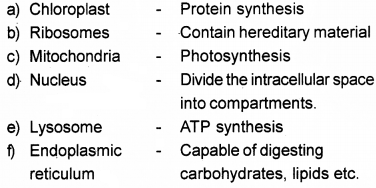
Answer:
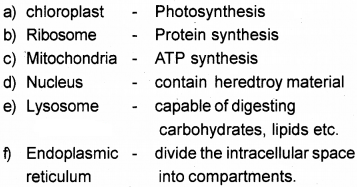
Question 7.
Identify the statement given below is true /false.
- Robert Brown discovered cell.
- Schleiden and 9chwann formulated cell theory.
- Virchow explained that cells are formed from preexisting cells.
Answer:
- False
- True
- True
Question 8.
Some cell organells are given below Endoplasmic reticulum, Golgi complex, mitochondria, chloroplast, vacuole, lysosome, microbodies, and centriole
- Identify the cell organelles belongs to the endomembrane system.
- Differentiate the cell organelles into membrane-bound and non-membrane bound.
- which is the cell organelle only found in animal cell but not in a plant cells.
Answer:
1. Endoplasmic reticulum, golgi complex .vacuole, lysosome
2.
| Membrane-bound | non-membrane-bound |
| Endoplasmic reticulum Golgi complex Mitochondria Chloroplast Vacuole Lysosome | Centriole |
3. centriole
Plus One Botany Cell The Unit of Life NCERT Questions and Answers
Question 1.
Which of the following is not correct?
(a) Robert Brown discovered the cell.
(b) Schleiden and Schwann formulated the cell theory.
(c) Virchow explained that cells are formed from preexisting cells.
(d) A unicellular organism carries out its life activities within a single cell.
Answer:
(a) Robert Brown discovered the cell.
Question 2.
Match the following.
| Column I | Column II |
| a) Cristae | i) Flat membranous sacs in the stroma |
| b) Cistenae | ii) Infoldings in mitochondria |
| c) Thylakoids | iii) Disc-shaped sacs in Golgi apparatus |
Answer:
| Column I | Column II |
| a) Cristae. | i) Infoldings in mitochondria |
| b) Cristina | ii) Disc-shaped sacs in Golgi apparatus |
| c) Thylakoids | iii) Flat membranous sacs in the stroma |
Question 3.
What is a mesosome in a prokaryotic cell? Mention the functions that it performs.
Answer:
In prokaryotes, the extension of plasma membrane into cell makes a membranous structure called mesosoma. They help in cell wall formation and DNA replication.
Question 4.
How do neutral solutes move across the plasma membrane? Can the polar molecules also move across it in the same way? If not, then how are these transported across the membrane?
Answer:
Neutral solutes move across the plasma membrane through osmosis. On the other hand, polar molecules cannot pass through the non-polar membrane. They require a carrier protein to help them to move across the membrane. Such transport requires energy and is called active transport.
Question 5.
What is stomatal apparatus? Explain the structure of stomata with a labelled diagram.
Answer:
Stomata are structures present in the epidermis of leaves. Stomata regulate the process of transpiration and gaseous exchange. Each stomata is composed of two bean-shaped cells known as guard cellls. In grasses, the guard cells are dumbbell-shaped.
The outer walls of guard cells (away from the stomatal pore) are thin and the inner walls (towards the stomatal pore) are highly thickened. The guard cells possess chloroplasts and regulate the opening and closing of stomata.
Question 6.
Which of the following is correct?
(a) cells of all living organisms have a nucleus.
(b) Both animal and plant cells have a well-defined cell wall.
(c) In prokaryotes, there are no membrane-bound organelles.
(d) Cells are formed de novo from abiotic materials.
Answer:
(c) In prokaryotes, there are no membrane-bound organelles.
Question 7.
New cells generate from
(a) bacterial fermentation
(b) regeneration of old cells
(c) pre-existing cells
(d) abiotic materials
Answer:
(c) Pre-existing cells
Plus One Botany Cell The Unit of Life Multiple Choice Questions and Answers
Question 1.
Which one is single membrane cell organelle?
(a) Endoplasmic reticulum
(b) Mitochondria
(c) Lysosomes
(d) Chloroplast
Answer:
(c) Lysosomes
Question 2.
The main function of lysosome is
(a) sexual reproduction
(b) extracellular digestion
(c) intracellular digestion
(d) Both (b) and (c)
Answer:
(d) Both (b) and (c)
Question 3.
Endoplasmic reticulum is in continuation with
(a) Golgi body
(b) nuclear wall
(c) mitochondria
(d) cell wall
Answer:
(b) nuclear wall
Question 4.
Which of the following is not a function of vacuole in plant cell?
(a) Storage
(b) Waste disposal
(c) Cell elongation and protection
(d) Production of hydrogen peroxide
Answer:
(c) Cell elongation and protection
Question 5.
The ATP synthase of chloroplasts is like that of
(a) peroxisomes
(b) Golgi body
(c) microsomes
(d) mitochondria
Answer:
(d) mitochondria
Question 6.
Fat is stored in the plant cell in
(a) lysosome
(b) spherosome
(c) microsome
(d) peroxisome
Answer:
(b) spherosome
Question 7.
F1 -particles comprise of
(a) head and base
(b) base and stalk
(c) head and stalk
(d) head, base, and stalk
Answer:
(a) head and base
Question 8.
Term basal body is associated with the development of
(a) cilia and flagella
(b) cell plate
(c) phragmoplast
(d) kinetochore
Answer:
(a) cilia and flagella
Question 9.
Golgi body receives materials from
(a) lysosome
(b) endoplasmic reticulum
(c) mitochondria
(d) cell membrane
Answer:
(b) endoplasmic reticulum
Question 10.
Quantasomes are found in
(a) mitochondria
(b) chloroplast
(c) lysosome
(d) endoplasmic reticulum
Answer:
(b) chloroplast
Question 11.
The term mitochondria was given by
(a) Benda
(b) Altmann
(c) Palade
(d) de Duve
Answer:
(a) Benda
Question 12.
The prokaryotic cell does not contain
(a) chromosome
(b) mitochondria
(c) plasma membrane
(d) ribosome
Answer:
(b) mitochondria
Question 13.
Organelle important in spindle formation during nuclear division is
(a) Golgi body
(b) chloroplast
(c) centriole
(d) mitochondrion
Answer:
(c) centriole
Question 14.
The surface of the endoplasmic reticulum (ER) is covered with
(a) ribosome
(b) DNA
(c) RNA
(d) glucose
Answer:
(a) ribosome
Question 15.
Spindles are formed by
(a) microtubules
(b) golgi body
(c) endoplasmic reticulum
(d) peroxisome
Answer:
(a) microtubules
Question 16.
In plants, vacuole contains
(a) soil
(b) water and dissolved substance
(c) cytoplasm
(d) All of the above
Answer:
(b) water and dissolved substance
Question 17.
Which cell organelle is present in both prokaryotic and eukaryotic cell?
(a) Ribosome
(b) Mitochondria
(c) ER
(d) Nucleus
Answer:
(a) Ribosome
Question 18.
Cilia are
(a) short (5-10 pm) hair-like narrow protoplasmic process
(b) with sweeping or bendular movements
(c) more numerous
(d) All of the above
Answer:
(d) All of the above
Question 19.
Chemiosmotic theory of ATP synthesis in the chioroplasts and mitochondria is based on
(a) proton gradient
(b) accumulation of K ions
(c) accumulation of Na ions
(d) membrane potential
Answer:
(a) proton gradient
Question 20.
An organism exclusively with 70S type of ribosomes contains one of the following
(a) DNA enclosed within the nuclear membrane
(b) circular naked DNA
(c) double-stranded DNA with protein coat
(d) single-stranded DNA with protein coat
Answer:
(b) circular naked DNA
